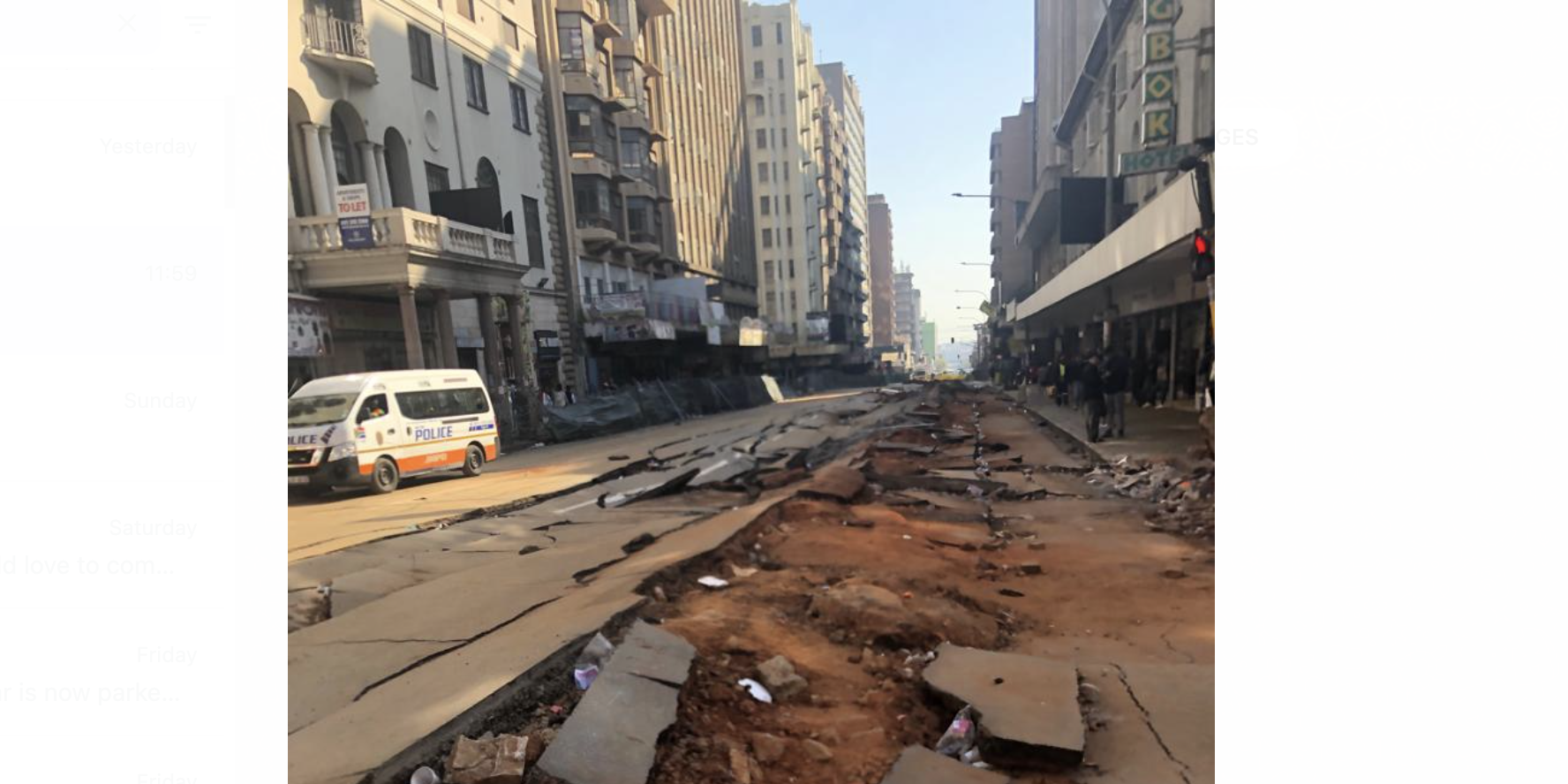Image: Thabo Mhambi / Bree Street, Johannesburg
Thina Nzo | Explosion of a decaying city: Defects of Joburg’s poor urban management revealed
[First published in News 24]
The rapid urbanisation and population density in Johannesburg have exerted enormous pressure on old infrastructure which has received little upgrades, modernisation and enforcement of contemporary safety regulations compliance measures, writes Thina Nzo.
The recent underground gas explosions which occurred in the Johannesburg CBD, where close to 40 people were injured and one person lost their life, is telling about the compounding defects of the City of Johannesburg’s urban infrastructure development and the adverse repercussions on public safety and the environment.
Although investigations are under way to establish the root cause of the gas explosion, gas expert companies, such as the Republic of Mozambique Pipeline Investments Company (Rompco), have highlighted some important factors that might have contributed to the gas explosion.
These factors are related to inconsistent routine inspections and irregular maintenance that ought to be done in order to identify and reduce potential leaks or damages.
Blame game
In Johannesburg, the underground gas pipeline distribution is predominantly owned by Egoli, but the compliance and regulations are done by the City of Johannesburg (CoJ). According to Egoli Gas, they believe it is unlikely that their gas pipeline or a leak caused the explosion in the CBD because their gas pipelines run under pavements, while the gas explosion happened on the surface of the road.
For now, there is much speculation and a blame-game is looming as to whether this explosion came from mining underground gas infrastructure or illegal mining activities that are happening in general. It leaves the public with an ambiguous picture of who should be held accountable.
Currently, the CoJ has multiple public and privately owned networks of underground infrastructure, such as gas pipes, stormwater drainage, sewage, drinking water pipes, electricity and telecommunications cables. Some of this infrastructure belongs to both public and private entities. The majority of this underground infrastructure was installed back in the early 1900s.
To date, the rapid urbanisation and population density in Johannesburg have exerted enormous pressure on old infrastructure which has received little upgrades, modernisation and enforcement of contemporary safety regulations compliance measures. Engineers have pointed out that gas pipelines developed back then were old designs that did not have proper ventilation and do not comply with present-day safety measures.
Intensifying this factor is the reality that CoJ’s underground infrastructure integrity has been compromised by a lack of substantial resource allocation for infrastructure maintenance, repairs and upgrading. While the CoJ is beginning to feel the pressures of rapid urbanisation, urban planning and management and investment into infrastructure development are critical for coping with urban modernisation. This also comes with updating and enforcing infrastructure policy regulations that can ensure communities are protected from infrastructure defects.
Gloomy picture
With regards to public infrastructure financing, the recent 2023/24 budget speech coined under the theme of “Let us make the impossible possible by making Joburg a centre for economic growth and development”, Dada Morero, who is the member of the mayoral committee (MMC) for finance in the City of Johannesburg painted a very gloomy picture about the financial situation at the CoJ.
With a revenue budget that is sitting at R80 billion and an operating expenditure budget of R74 billion for the 2023/24 financial year, CoJ continues to face major financial constraints related to loss of revenue collection from rates, electricity and water sale which is linked to unemployment crisis that has reduced household disposable income to pay for municipal services. This has resulted in increased indigency support to consumers. These financial constraints have a dire implication on the City’s fiscal allocations needed for infrastructure asset repairs and maintenance, a function of the City that does not generate much revenue.
The National Treasury has recommended that municipalities should allocate at least 40% of their capital budget to the rehabilitation and upgrading of existing assets, and allocations to repairs and maintenance should be set at 8%. The CoJ has acknowledged it does not meet the 8% allocation over the 2023/24 to 2025/26 medium term. The Environment and Infrastructure Services Department, which is responsible for infrastructure upgrades and maintenance, has been allocated an operational expenditure budget of R133.7 million and R57 million for the three-year capital budget.
According to the City, it requires R4 billion every month to service the City and address its infrastructure needs. At the same time, the City’s funding model continues to rely on revenue generated from trading services as a primary source of revenue, followed by grants and loans. This means that the CoJ will heavily rely on loans and grant allocations to address its infrastructure development and maintenance.
By-laws not enforced
Yet, the CoJ also failed to spend R762 million in grant allocations in 2021/22. With regards to private infrastructure, private entities submit wayleave applications to the City to install underground infrastructure. However, compliance with maintenance and upgrades is left to the behest of the private sector.
Due to CoJ’s lack of institutional capacity, the City fails to enforce building safety regulations by-laws, particularly routine inspections of privately installed hazardous energy distribution infrastructure such as gas. This also applies to routine inspections on buildings, health and safety compliance, of which some of these functions are shared with the labour department.
The politics of bureaucratic territorialism between provincial and local governments does negatively affect cooperative governance in multi-government shared services. This also resonates with the territorial conflict which played out in the public domain this week between the ANC provincial leadership and Patriotic Alliance council leaders during the gas explosion emergency, which demonstrates a peculiarly multi-layered pathological state of coalition urban governance.
This also illuminates how coalition partners continue to grapple with political cohesion that has been characterised by parochial politics underscored by the clamour for power and territorial control. Cohesive political leadership and direction within the coalition is needed now more than before in CoJ.
In order to ally public safety anxiety, firstly, the City administration should provide the public with an infrastructure audit on the state of private and public underground infrastructure and a plan on how it will attend to aging infrastructure, working with other spheres of government and the private sector.
Secondly, the mayoral committee should urgently focus on fixing its finances and ensure that resources are efficiently allocated and spent on infrastructure maintenance and upgrades in order to future-proof the collapse of the City’s infrastructure.
Thirdly, the council, particularly its portfolio committees, should develop a robust oversight agenda over the City’s spatial infrastructure. The infrastructure and finance portfolio committees should ensure that the infrastructure grant expenditure is spent on maintenance and upgrades, and the health and environment portfolio committee should monitor the enforcement of infrastructure safety regulations for both public and private entities.
This will ensure that clear lines of accountability are drawn, and citizens know whom to hold politically accountable for the collapse of infrastructure should incidents such as these occur in the future.
– Dr Thina Nzo is a local government senior researcher at the Public Affairs Research Institute.


